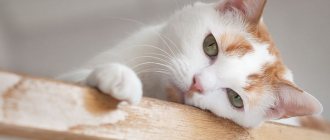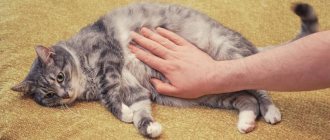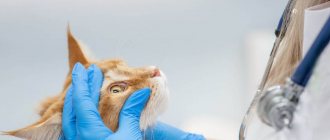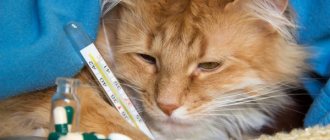Reasons for changes in respiratory rate in cats
1. Physiological reasons - a natural reaction of the body, which is the norm. It can be caused by:
- physical activity. In healthy animals, respiratory rate depends mainly on the level of physical activity. The calmest breathing in cats is during sleep;
- stress. When nervous, angry, or excited, the cat's breathing quickens. For example, while traveling in a car, when moving to a new place, during various medical procedures. This is a short-term phenomenon and goes away as soon as the source of stress disappears. In pregnant, giving birth, lactating and estrus cats, breathing also often noticeably increases, but this is not a cause for concern, since this is a normal reaction of the body to additional stress;
- overheating or hypothermia. When overheated, a cat breathes through its mouth, often and heavily. He tries to spread out his whole body on the coolest surface in the house - tiles, linoleum or under the bathtub. If the temperature in the room is too high, wet a towel with cold water and wrap it around your pet, or simply wet his ears and underbelly, and make sure he drinks enough. When hypothermia occurs, on the contrary, breathing is barely noticeable, the pet curls up into a ball, and the fur stands on end for better thermal insulation. In this case, wrap him in a warm blanket.
2. Pathological causes - caused by various diseases or abnormalities. Among them:
- injuries to the chest, spine and ribs. If your cat sticks out his tongue and breathes frequently, taking small, shallow breaths, then breathing may be causing him pain. He may try to hide away from everyone, walk carefully, as if his movements are constrained, and eat poorly. In this case, the animal must be carefully examined. If there are wounds, torn hair, or some areas of the body are extremely painful when touched, take him to the vet immediately;
- foreign body in the throat or nose. Look into the cat's throat. If you notice an object stuck in your larynx and making it difficult to breathe, try to remove it. If it doesn’t work the first time, go to the clinic immediately, otherwise repeated attempts can only push it deeper. If the cat wheezes when breathing through the nose, or a whistle is heard, then it seems that a foreign body is stuck in the nasal passage;
- deterioration of health due to the development of various diseases and pathologies. In such cases, a change in breathing rate is accompanied by other alarming symptoms - an increase or decrease in the cat’s body temperature, signs of dehydration, vomiting, coughing, discharge from the eyes and nose. Wheezing in the chest is a symptom of stagnation of fluid or mucus, which occurs with pneumonia or heart disease. When a cat breathes with his tongue hanging out, it is possible that the nasopharyngeal mucosa is so inflamed that breathing through the nose is almost impossible.
Additional symptoms and complications
Rapid breathing caused by physiological reasons does not cause discomfort to the cat.
Additional symptoms and complications:
- severe frequent attacks of suffocating cough;
- a sharp increase in temperature;
- inadequate response to stimuli;
- anemia, pallor, cyanosis, excessive redness of the mucous membranes;
- nose bleed;
- heart rhythm disturbances (arrhythmia, tachycardia, bradycardia);
- change in habitual behavior (anxiety, nervousness, depression, apathy);
- strong thirst;
- wheezing;
- unnatural poses;
- discharge from the nose, eyes, mucous, purulent;
- fast fatiguability;
- trembling, muscle spasms, cramps;
- frequent urination;
- refusal to eat;
- vomiting, profuse diarrhea;
- weight loss.
If, in addition to tachypnea, the cat loses consciousness, is not oriented in space, is choking, is breathing heavily intermittently, wheezing, whistling sounds are heard, the heart rate has changed, do not waste a minute. Contact your veterinarian immediately or take your cat to a veterinary clinic.
Cardiopalmus
Rapid heartbeat is one of the symptoms most often noted with tachypnea.
The heartbeat changes after taking certain medications. For example, after vaccination. This is how the body responded to the vaccine. In this case, respiratory function should recover within 12-24 hours.
If your cat's mucous membranes turn blue, the heart rate increases (arrhythmic pulse), the pet loses consciousness, breathes heavily, behaves inappropriately, do not waste a minute. Call a veterinarian at home or take it in a shipping box to the nearest veterinary hospital.
Heat
High temperature and rapid breathing can be caused by both external and internal factors. Overheating, dehydration, stress, childbirth, hormonal changes, intestinal disorders, acute poisoning, respiratory, viral and bacterial diseases, acute inflammation.
An increase in temperature can be observed in a cat after vaccination, deworming, or at the beginning of the development of inflammatory processes in the body.
Lethargy and apathy
As we have already noted, if a cat has rapid, pathological breathing, in some conditions the cat may experience either severe agitation or possible lethargy and apathy.
Important! Lethargy and apathy can be caused by exhaustion, shock, or neoplasia.
The alarm should be sounded in the case of a lethargic state, severe depression, cyanosis of the mucous membranes, lack of response to external stimuli, and unstable temperature.
Convulsions
Convulsions, rapid breathing, muscle spasms, tremors in a cat can occur against the background of neurotic conditions, severe intoxication, poisoning with potent poisons, chemicals, medications, or ingestion of exogenous toxins.
The development of this condition is facilitated by impaired gas exchange, oxygen starvation, shock, and strong emotional overexcitation.
The most common diseases:
- excessive weight (obesity) - the cat breathes with its mouth open even after minor physical activity;
- allergic reactions, asthma (accompanied by coughing, sneezing, swelling of the larynx);
- infectious diseases (for example, bronchitis if the cat has a fever and cough);
- various pathologies of the internal organs of the chest and abdominal cavity (then the cat breathes with its “stomach”).
There are many accompanying symptoms, and you should carefully monitor the animal to inform the veterinarian of all the details. In such serious cases, only a specialist will make the correct diagnosis and prescribe treatment.
Carbon monoxide poisoning
This type of poisoning can be provoked by prolonged stay in places where cars accumulate, near highways, highways, in parking lots, in garages when the car engine is warming up, in cramped rooms with low oxygen concentrations, in case of gross violations of the operation of stoves in baths and saunas and, of course, in case of fires and major fires.
Signs of CO Poisoning
Blue complexion, loss of consciousness. In severe poisonings, deaths are common due to respiratory arrest and cardiac arrest.
Symptoms
- dizziness and headache
- active lacrimation or pain in the eyes
- nausea and vomiting
- dry, persistent cough and chest pain
- shortness of breath
Reactions to a high concentration of carbon monoxide in the lungs can be different, including visual and auditory hallucinations, rapid heartbeat, redness of the skin, involuntary urination and defecation, severe convulsions, and the victim’s reaction to light decreases. The danger lies in the appearance of an increasing drowsiness and the onset of complete motor paralysis, followed by the development of coma.
In the future, with complications of coma, cerebrovascular accident, visual impairment, and cerebral edema may occur. Possible skin lesions in the form of blisters and subsequent death of skin cells due to necrosis, the development of pneumonia.
First aid for gas poisoning
The very first thing to do is provide the victim with fresh air. Take him outside and lay him on his back. Allow him to breathe freely; if his chest is constrained by clothing, you need to remove it. It is imperative to ensure that the victim is breathing and that they are able to breathe on their own. If breathing is not heard or is barely noticeable, artificial respiration is necessary.
To eliminate the negative effects of inhaling carbon monoxide vapor, you can give the victim a cotton swab to sniff and thoroughly rub his body.
To avoid negative consequences and complications of the nervous and respiratory systems, you need to take the person to the nearest medical center. It is worth noting that the sooner you take the victim to the hospital, the better. This is necessary to ensure that oxygen therapy can be used as quickly as possible, since clean air is crucial for it.
With mild carbon monoxide poisoning, nausea may occur, but you can easily cope with it with a 0.5% solution of novocaine inside the body. Strong tea or coffee will help.
How to help at home?
First of all, examine the cat’s oral cavity and look into the throat:
- if the cat is breathing heavily with his mouth open, and strong wheezing, gurgling, whistling is heard in the chest, or fluid is flowing from the mouth and nose, immediately take him to a specialist. There is nothing you can do to help, and a delay may cost the animal its life;
- if the mucous membrane of the mouth and gums are too pale, with a purple or blue tint, then the cat is suffocating. If he has almost stopped breathing, you need to give him artificial respiration.
Kidney pathologies
One of the most common diseases in older cats is kidney problems. This is especially true for castrati. We are talking about urolithiasis , in which uroliths form in the kidneys and/or bladder. These are stones based on uric acid salts. If they looked like sea pebbles smoothly rounded with water, they would hardly pose a danger to the life of the animal. The problem is that uroliths have very diverse shapes and sharp, almost cutting, edges.
Even when urinating, when the bladder contracts, they cause the cat unbearable, cutting pain. Because of this, any “small” trip turns into real torture for the animal. Urine takes on the rich color of beet juice and is released in small portions. The cat wheezes and meows loudly whenever he goes to the toilet.
But it’s much worse if stones have formed in the kidneys. Pain in this case can occur at any time, overtaking the animal suddenly. Their intensity is such that so-called renal colic begins. If they are not stopped with powerful painkillers, another attack can lead to the death of the cat from acute painful shock. More details in the video below:
Treatment of urolithiasis depends on the severity of the case, the number and location of the stones, as well as the immediate condition of the animal. If there are few uroliths and they are small, the veterinarian (when the clinic’s equipment allows) can use an ultrasound machine to destroy them. When the animal's condition is severe, surgery is recommended. When the cat may not survive it (he is too old), maintenance therapy is prescribed, which involves the administration of painkillers. Unfortunately, in the most severe cases, euthanasia is recommended.










